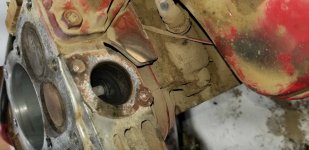First, never use a HSS or carbide tool in a part you need to keep. Grind, file or chisel off the frozen stud. Use a tiny cold chisel to make a screw slot. Apply a penetrating lubricant, kerosene or similar. Try screw in then out several times. If that fails use a satellite drill to remove the stud core. Then grind down a hacksaw blade, cut radially out to the full thread depth on both sides, this will weaken the joint to some extent. Use the tiny cold chisel and tweezers to loosen and remove the pieces of the stud.
If you can’t get a stellite drill you will need to use ultrasonic or electrochemical erosion.
Before you replace the stud tap the hole, very carefully, with a plug or bottoming tap. Use the best cutting lubricant you can get your hands on. Then buy or make a stud at least 50% longer than the original. Also, buy or make a high tensile collar, for the extra length. Cross sectional area of the collar should be the same as the bolt core plus about 20%. Then tighten the nut on the new stud. The extra length will work as a really stiff spring to accommodate, to some extent, any differential thermal expansion.
Wherever possible add 75% to the stud length. The collar can be made from a Grade 12.9 bolt or a Grade 8.8 with extra area if the studs are Grade 12.9.
If you can’t get a stellite drill you will need to use ultrasonic or electrochemical erosion.
Before you replace the stud tap the hole, very carefully, with a plug or bottoming tap. Use the best cutting lubricant you can get your hands on. Then buy or make a stud at least 50% longer than the original. Also, buy or make a high tensile collar, for the extra length. Cross sectional area of the collar should be the same as the bolt core plus about 20%. Then tighten the nut on the new stud. The extra length will work as a really stiff spring to accommodate, to some extent, any differential thermal expansion.
Wherever possible add 75% to the stud length. The collar can be made from a Grade 12.9 bolt or a Grade 8.8 with extra area if the studs are Grade 12.9.

